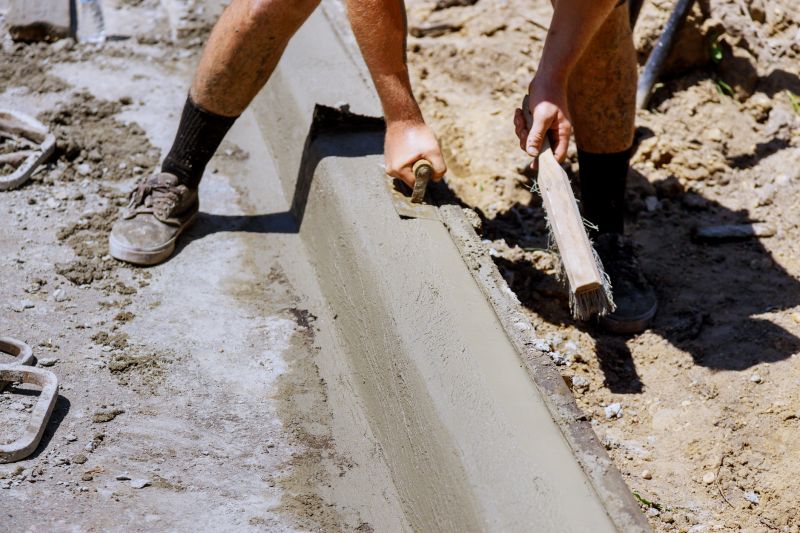Favorite Products For Precise Concrete Curb Making
Select from the most recommended products that ensure clean lines and professional finishes in your concrete curb projects.
 Concrete curb installations are essential components in landscape design, property boundaries, and traffic management. They serve to contain and define areas such as lawns, walkways, driveways, and roadways, providing structural support and aesthetic appeal. Selecting the right products for curb installation can influence the durability, appearance, and ease of construction of the project. From pre-formed concrete curbs to flexible edging options, there is a wide array of products designed to meet various project requirements.
Concrete curb installations are essential components in landscape design, property boundaries, and traffic management. They serve to contain and define areas such as lawns, walkways, driveways, and roadways, providing structural support and aesthetic appeal. Selecting the right products for curb installation can influence the durability, appearance, and ease of construction of the project. From pre-formed concrete curbs to flexible edging options, there is a wide array of products designed to meet various project requirements.
Top Overall Option
Pre-formed Concrete Curb Sections
Pre-formed concrete curb sections are a versatile option that simplifies installation by providing ready-made segments that can be easily aligned and secured. They are available in various sizes and profiles to match different design needs, and often feature interlocking features for stability. These sections are suitable for creating clean, straight lines or gentle curves, making them a popular choice for both residential and commercial projects. Their durability and straightforward installation process make them a reliable option for many curb applications.
Types of Products For Concrete Curb Installations
Pre-formed Concrete Curb Sections
Pre-formed segments designed for quick and consistent installation, available in various profiles.
Flexible Plastic Edging
Flexible strips that contour easily around curves, ideal for decorative borders.
Cast-in-Place Concrete Forms
Reusable forms used to pour custom concrete curbs directly on-site.
Concrete Curb Mixes
Specialized concrete mixes formulated for curb construction, offering workability and durability.
Reinforcement Bars and Mesh
Steel reinforcements used to strengthen concrete curbs against cracking.
Curb Anchors and Connectors
Hardware that secures curb sections together or anchors them to the ground.
Edging Brackets and Stakes
Support hardware to hold flexible edging in place during installation.
Sealants and Joint Fillers
Materials used to seal joints and improve curb longevity.
Form Release Agents
Chemical agents to facilitate easy removal of forms after concrete curing.
Decorative Curb Caps
Caps and finishes that enhance the aesthetic appeal of concrete curbs.
Drainage Grates and Inserts
Components integrated into curbs to allow water flow and drainage.
Concrete Coloring Agents
Additives that provide color options for decorative curb finishes.
Form Liners
Molds used to imprint patterns or textures onto freshly poured concrete.
Curb Repair Kits
Products designed for fixing or patching damaged curbs.
Expansion Joints
Materials that allow for movement and prevent cracking in concrete curbs.
Popular Choices
Widely used for their ease of installation and consistent appearance.
A common choice for decorative and curved borders.
Popular among professionals for custom curb shaping.
Selected for their workability and strength in curb projects.
Frequently used to enhance the durability of concrete curbs.
Helpful for securing curb sections together securely.
Commonly used to hold flexible edging in place during installation.
Popular for sealing joints and preventing water ingress.
Chosen for aesthetic enhancements of curb edges.
Often incorporated into curbs for effective water management.
Used to achieve various decorative effects.
Popular for creating decorative surface patterns.
Frequently sought for maintenance and patching.
Commonly used to accommodate movement in concrete curbs.
When planning a concrete curb installation, it is important to consider the specific application, site conditions, and the desired aesthetic. Proper preparation of the base, accurate measurement, and correct product selection are key to achieving a professional-looking result. Many products are designed to be user-friendly, allowing both DIY enthusiasts and professional contractors to work efficiently. Additionally, some products offer features like easy installation, weather resistance, and compatibility with different concrete mixes.
Understanding the range of available products helps in making informed decisions that align with project goals. For example, rigid concrete curbing provides a solid and long-lasting boundary, ideal for high-traffic areas, while flexible edging can be suitable for curves and decorative borders. Accessories such as connectors, reinforcement bars, and sealing compounds further enhance the integrity and finish of the curb installation. Whether for a small residential project or a large commercial landscape, choosing the appropriate products ensures a durable and visually appealing outcome.
Key Buying Considerations
- Project scale and size to determine the quantity and type of curb products needed.
- Material durability and resistance to weather conditions in your area.
- Ease of installation, especially if undertaking a DIY project.
- Design compatibility with existing landscape or roadway aesthetics.
- Flexibility of materials for curved versus straight sections.
- Compatibility with concrete mixes and other construction materials.
- Availability of accessories such as connectors, reinforcement, and sealants.
- Budget constraints and cost-effectiveness of different product options.
- Long-term maintenance requirements and repair options.
- Environmental factors such as ground stability and drainage needs.
- Local building codes or regulations that may influence product choice.
- Ease of transportation and handling of materials on-site.
- Compatibility with existing infrastructure or landscape features.
- Availability of technical support or guidance from suppliers.
- Product reviews and recommendations from other users or professionals.
This content may contain affiliate links. We earn commissions to support our work and provide helpful information.
